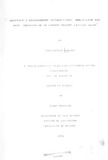| dc.description.abstract | Eight introduced and three existing onion cultivars were evaluated at four locations for two seasons to determine genotype-environment interactions and stability for bulb yield, and other agronomic characters. The cultivars were then evaluated for their shelf-life. They were also vernalized at four temperature regimes (5°C,10°C, Njabini 2530 m and Kabete 1820 m room temperature ) to induce flowering and seed production. Experimental design for GxE and storage experiments was randomised complete block design with five and three replicates, respectively. Seed production trial was in a split plot design with three replicates.
Genotypic effects were highly significant for all traits except days to maturity. Genotype - environment interactions were highly significant for all traits.The nature of genotype x environment interactions and stability analysis were investigated by regression analysis technique of Eberhart and Russell (1966). Results showed a considerable portion of genotype x environment interactions for bulb yield and shape could be attributed to the linear regressions. The significant GxE (linear) variance indicated that there were genetic differences among the cultivars for their regression on the environmental index.
All exotic cultivars had better bulb yield than the
existing ones. Cultivar K0N2 had good adaptation and stability but had below average bulb yield. Cultivar K0N4 had high bulb yield and general adaptability but lacked stability for this trait. The exotic cultivars did not have a great advantage over existing cultivars for maturity. Cultivar K0N5 was the earliest while K0N8 was the latest to mature. A11 cultivars except K0N3 and Bombay Red were not stable for duration to maturity. Cultivar K0N6 was early maturing, widely adapted but not stable for maturity.
Combined analysis for shelf-life indicated that location and cultivar effects and their interactions were significant. The exotic cultivars stored better than the existing ones. Best storing exotic cultivars were K0N1 and K0N4 with 27.2 and 35.6% storage loss .respectively, after four, months of storage at Kabete. The existing cultivars and KGN6 had 75% storage loss in four months.
Location, varietal and storage temperature effects were highly significant for all traits considered in seed production trial except percentage germination. Only varietal effects were significant for percentage germination. A11 interactions were also significant for al 1 traits except germination. Var. x Temp. was significant for germination. Bulbs ,stored at 103C flowered earlier and had higher seed yield than those
stored at 5°C, Njabini and Kabete room temperature. Bulbs that were naturally vernalised at Njabini had successful flowering in al1 locations. The exotic cultivars had higher seed yield than the existing ones. The highest seed yielding cultivars were K0N7 and K0N1. Marigat was the most favourable location for seed production | en_US |



